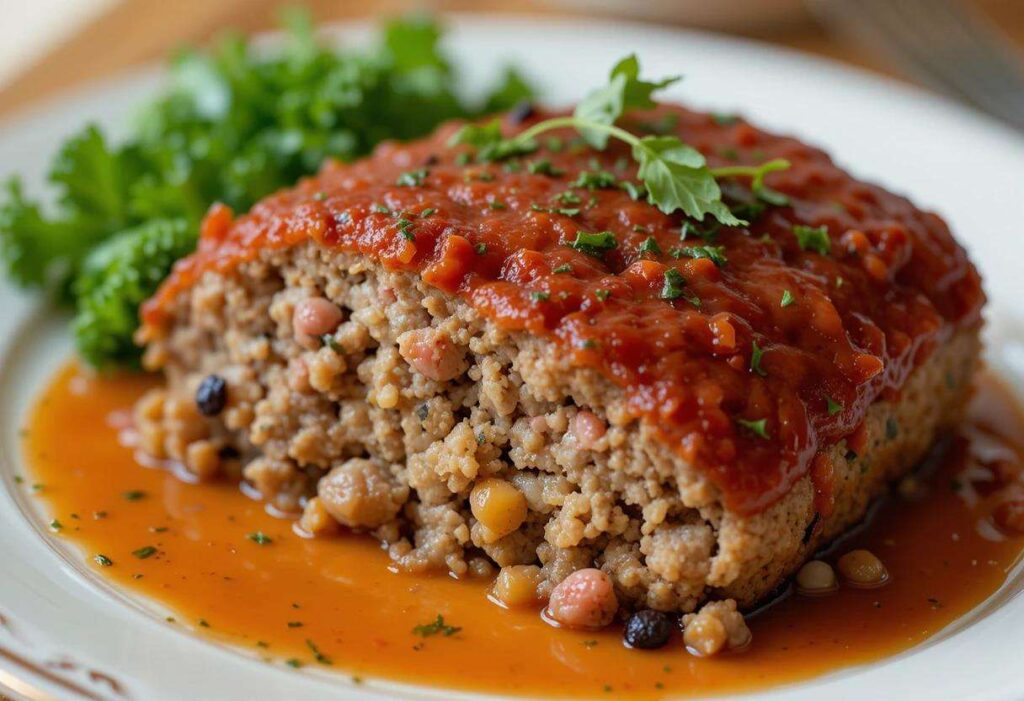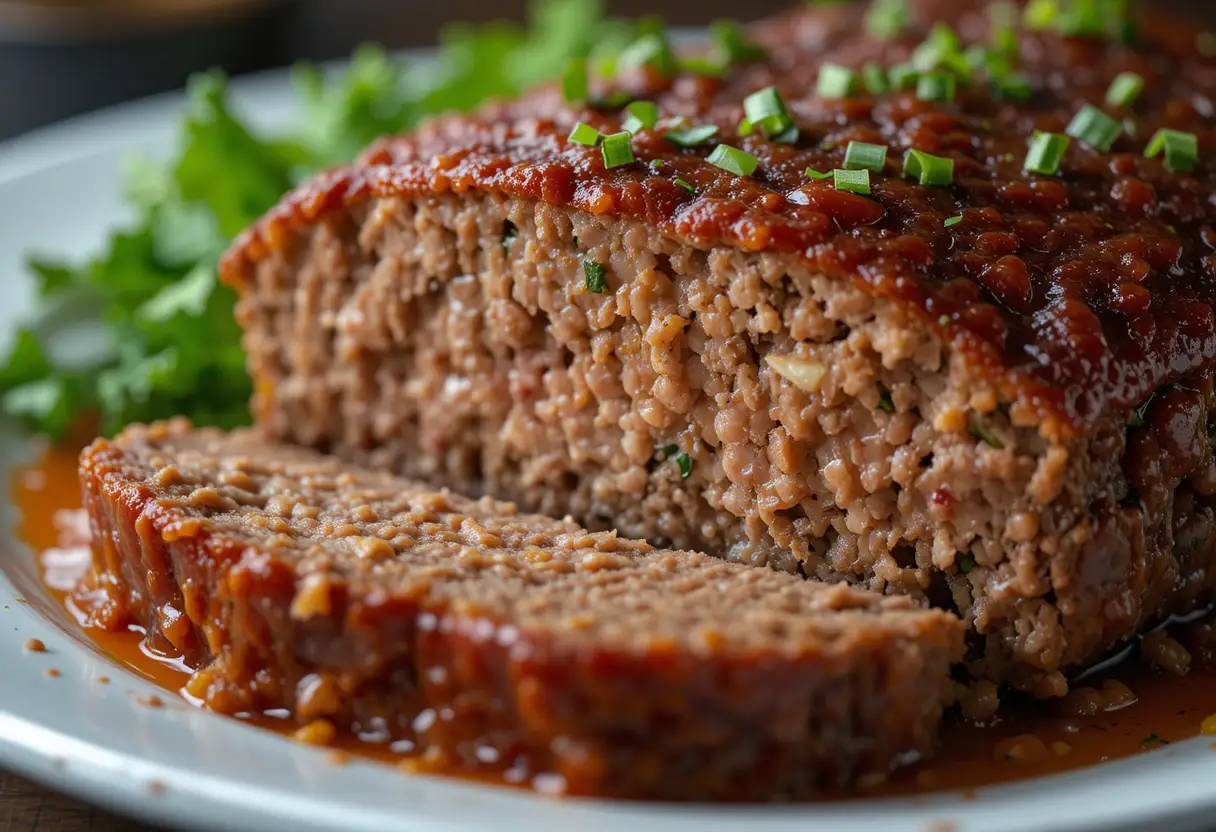Italian cuisine is a symphony of flavors, history, and culture, and one of its hidden gems is Italian meatloaf, or “Polpettone”. This traditional dish is a perfect blend of rustic charm and culinary elegance. Whether served at a family gathering or as a hearty weeknight meal, Italian meatloaf stands out for its unique ingredients and preparation methods. In this guide, we’ll take you through the origins, defining characteristics, and step-by-step instructions for crafting an authentic Italian meatloaf.

Table of Contents
Origins of Italian Meatloaf: A Culinary Journey
The roots of Italian meatloaf trace back to the countryside kitchens of Italy, where resourcefulness was key. Known as Polpettone, this dish was born from the need to create a satisfying meal from limited ingredients. Italian cooks ingeniously combined ground meats with breadcrumbs, eggs, and aromatic herbs to craft a dish that was both filling and flavorful.
Unlike its American counterpart, Italian meatloaf often incorporates traditional Mediterranean elements like sun-dried tomatoes, Parmesan cheese, and fresh basil. Regional variations abound across Italy, with some versions featuring fillings like prosciutto, hard-boiled eggs, or even mozzarella. Each recipe tells the story of its region, influenced by local produce and cultural nuances.
Defining Characteristics of Italian Meatloaf Compared to Classic American Meatloaf
While American meatloaf has earned its place as a comfort food staple, Italian meatloaf sets itself apart with its distinctive ingredients and preparation techniques. Here’s how the two compare:
- Flavor Profiles:
- Italian Meatloaf: Rich, earthy flavors from herbs like oregano, thyme, and parsley; bursts of umami from Parmesan and sometimes anchovies.
- American Meatloaf: Bold and hearty, often featuring ketchup or barbecue sauce for tangy sweetness.
- Ingredients:
- Italian Meatloaf: Ground pork and beef, breadcrumbs soaked in milk, Parmesan, garlic, and often prosciutto or pancetta for depth.
- American Meatloaf: Typically ground beef with breadcrumbs, onion, and sometimes green bell peppers, bound with eggs and seasoned with Worcestershire sauce.
- Cooking Techniques:
- Italian Meatloaf: Baked and sometimes simmered in a tomato-based sauce, enhancing the flavor and moisture.
- American Meatloaf: Baked with a glaze of ketchup or a similar topping, creating a caramelized crust.
- Presentation:
- Italian Meatloaf: Often sliced and served with a side of sautéed vegetables or a light salad, garnished with fresh herbs.
- American Meatloaf: Served with mashed potatoes and gravy or alongside green beans for a classic diner-style plate.
By understanding these defining characteristics, you’ll not only appreciate the cultural depth of Italian meatloaf but also be well-equipped to recreate its authentic flavors in your own kitchen. Stay tuned for the ultimate recipe and step-by-step guide in the following sections.
Essential Ingredients for Italian Meatloaf
Crafting an authentic Italian meatloaf begins with selecting the right ingredients in the right proportions. Each component plays a pivotal role in creating the perfect balance of flavor, texture, and aroma. Here’s a breakdown of the essentials.
The Role of Ground Meats: What Makes the Perfect Blend?
The foundation of any great Italian meatloaf is its blend of ground meats. The ideal combination balances flavor, fat content, and moisture:
- Ground Beef: 500g (1 lb)
Provides a hearty, robust flavor as the base of the meatloaf. - Ground Pork: 250g (½ lb)
Adds fat and a subtle sweetness to keep the meatloaf tender. - Optional: Ground Veal (250g or ½ lb)
For a more delicate texture and refined taste.
The ratio of meats is crucial—aim for a 2:1 ratio of beef to pork for a well-rounded flavor.
Key Herbs and Spices: Elevating Flavors
Herbs and spices are what give Italian meatloaf its signature Mediterranean essence. Use the following in measured quantities for authentic flavor:
- Fresh Parsley: 2 tablespoons, finely chopped
Adds a fresh, peppery note. - Dried Oregano: 1 teaspoon
Brings a classic Italian aroma. - Fresh Basil: 2 tablespoons, finely chopped
Infuses the meatloaf with fragrant sweetness. - Garlic: 2 cloves, minced
A must-have for savory depth. - Salt: 1½ teaspoons
Enhances all the flavors. - Black Pepper: 1 teaspoon
Adds a subtle kick.
Binding Agents: Bread Crumbs vs. Oats
To hold the meatloaf together, binding agents are essential. Here’s how to choose:
- Italian Breadcrumbs: 1 cup
Soaked in ¼ cup of milk for added moisture, breadcrumbs integrate seamlessly into the mixture, providing structure and tenderness. - Oats (Optional): ¾ cup
For a slightly nuttier texture, though less traditional.
Eggs are also critical as binders:
- Eggs: 2 large
Ensure the mixture holds together during cooking.
Step-by-Step Cooking Guide
Preparing Your Ingredients
- Gather Ingredients: Ensure all your components—meats, herbs, and binders—are measured and ready.
- Preheat Oven: Set your oven to 180°C (350°F).
- Soak Breadcrumbs: Combine breadcrumbs and milk in a small bowl; let them sit for 5 minutes.
Mixing Techniques to Ensure Flavor and Moisture
- Combine Meats: Place the ground beef, pork, and optional veal in a large mixing bowl.
- Add Aromatics: Mix in parsley, oregano, basil, garlic, salt, and pepper.
- Integrate Binders: Add soaked breadcrumbs and eggs to the meat mixture.
- Gently Mix: Use your hands to mix the ingredients, ensuring even distribution without overworking the meat (to avoid a dense texture).
Baking Tips: Temperature and Time for Perfect Doneness
- Shape the Meatloaf: Form the mixture into a loaf shape and place it on a lined baking sheet or in a greased loaf pan.
- Optional Sauce Topping: For extra flavor, spread a thin layer of marinara sauce over the loaf before baking.
- Bake: Place the meatloaf in the preheated oven and bake for 50-60 minutes. Use a meat thermometer to ensure the internal temperature reaches 70°C (160°F).
- Rest Before Slicing: Let the meatloaf rest for 10 minutes after removing it from the oven. This allows the juices to redistribute, ensuring every bite is moist and flavorful.
Follow these steps, and you’ll master the art of crafting a perfect, authentic Italian meatloaf that will delight your family and friends.
Variations of Italian Meatloaf
Italian meatloaf is a versatile dish that allows for creativity and personalization. Here, we explore some unique variations that cater to different preferences and showcase regional Italian influences.
Vegetarian Alternatives: How to Adapt the Recipe
For those seeking a plant-based version of this classic dish, here’s how to recreate its essence without meat:
- Protein Base: Substitute ground meats with lentils, chickpeas, or a combination of mushrooms and tofu. Use about 2 cups of cooked legumes or finely chopped mushrooms.
- Binders: Replace eggs with flaxseed meal (1 tablespoon mixed with 2.5 tablespoons water per egg).
- Flavor Enhancers: Incorporate Parmesan-style vegan cheese, nutritional yeast, and extra herbs to mimic the savory flavor of traditional meatloaf.
- Texture: Use finely chopped nuts like walnuts or sunflower seeds for a meaty bite.
Regional Twists: Northern vs. Southern Italian Influences
Italy’s diverse regions bring unique touches to this dish:
- Northern Italian Meatloaf: Often incorporates ingredients like ricotta cheese for creaminess and a touch of nutmeg for warmth. In regions like Lombardy, you might find fillings such as spinach and prosciutto.
- Southern Italian Meatloaf: Features bold flavors with additions like sun-dried tomatoes, capers, olives, or spicy Calabrian chili flakes. Mozzarella or Pecorino cheese is often used for its tangy richness.
Creative Stuffings and Toppings
Stuffings and toppings elevate Italian meatloaf to new heights. Here are some ideas:
- Stuffings:
- Hard-boiled eggs for a visually striking cross-section.
- Roasted red peppers and provolone for a melty, flavorful center.
- Spinach and ricotta for a classic Italian twist.
- Toppings:
- A layer of marinara sauce sprinkled with Parmesan for added moisture and flavor.
- A crust of breadcrumbs mixed with olive oil, garlic, and parsley for a crunchy finish.

Nutritional Information
Caloric Content and Health Benefits
Italian meatloaf is not just delicious but can be a balanced meal. Here’s a general nutritional breakdown for a standard serving (approx. 150g):
- Calories: 300-350
- Protein: 25-30g
- Fats: 15-20g (primarily from meats and cheese)
- Carbohydrates: 10-15g (from breadcrumbs and other additives)
- Fiber: 1-2g (can be increased with vegetable fillings or oat binders)
Health benefits include high protein content for muscle repair and energy, essential fats for brain health, and vitamins from herbs and vegetables.
Adapting the Recipe for Specific Dietary Needs
- Low-Calorie Version: Use lean ground turkey or chicken instead of beef and pork. Replace breadcrumbs with almond flour.
- Gluten-Free: Swap breadcrumbs with gluten-free panko or rolled oats.
- Low-Carb/Keto: Replace breadcrumbs with crushed pork rinds or grated Parmesan cheese.
- Dairy-Free: Omit Parmesan and use nutritional yeast or a dairy-free cheese alternative.
Storage and Reheating Best Practices
Proper storage and reheating ensure that your Italian meatloaf retains its flavor and texture even after a few days.
How to Keep Italian Meatloaf Fresh Longer
- Refrigeration: Wrap the meatloaf tightly in plastic wrap or aluminum foil and place it in an airtight container. Store for up to 3-4 days.
- Freezing: For longer storage, wrap individual slices in plastic wrap and store them in a freezer-safe bag or container. Freeze for up to 3 months.
The Best Methods for Reheating Without Losing Moisture
- Oven Method: Place slices in a baking dish, cover with foil, and heat at 175°C (350°F) for 15-20 minutes. Add a splash of broth or marinara sauce to keep it moist.
- Microwave: Cover the meatloaf with a damp paper towel and microwave in 30-second intervals until heated through.
- Stovetop: Heat slices in a skillet over medium-low heat with a bit of olive oil or sauce to retain moisture.
By exploring these variations and following proper storage practices, you can enjoy Italian meatloaf in all its delicious forms, tailored to your taste and lifestyle.
Common Mistakes and How to Avoid Them
Overmixing the Meat: Impacts on Texture
Overmixing the ingredients can lead to a dense and tough meatloaf. The key is to mix just until all components are evenly incorporated. Use a gentle hand and avoid overworking the mixture, as this compresses the proteins and eliminates air pockets, which are essential for a tender texture.
Underseasoning: How to Get the Flavors Right
A bland meatloaf is a common disappointment. To achieve the bold, savory flavors of Italian cuisine:
- Generously season with salt, pepper, and Italian herbs like oregano, parsley, and basil.
- Taste test the mixture by frying a small portion before baking to adjust seasoning as needed.
- Don’t forget to include flavorful elements like garlic, Parmesan cheese, and sun-dried tomatoes.
Frequently Asked Questions
What are the best meats to use for Italian meatloaf?
A combination of ground beef and ground pork is the classic choice for Italian meatloaf, offering a balance of flavor and moisture. For a lighter option, you can include ground turkey or chicken. Adding a small amount of ground veal can elevate the texture to a more delicate consistency.
How can I make my meatloaf juicier?
To ensure a moist meatloaf:
- Incorporate breadcrumbs soaked in milk or broth.
- Include ingredients with high moisture content, like sautéed onions or grated zucchini.
- Avoid overcooking; aim for an internal temperature of 70°C (160°F).
- Let the meatloaf rest for 10 minutes after baking to allow juices to redistribute.
What are some quick fixes if my meatloaf falls apart?
If your meatloaf isn’t holding together:
- Add an extra egg or a handful of breadcrumbs to bind the mixture more effectively.
- Ensure ingredients are evenly combined without being overmixed.
- Chill the shaped loaf in the refrigerator for 30 minutes before baking to firm it up.
Are there any specific spices that are a must for an authentic Italian flavor?
Yes! Essential spices and herbs include:
- Oregano: For a signature Italian aroma.
- Parsley: Adds freshness and balance.
- Basil: A touch of sweetness and fragrance.
- Garlic: For depth and richness.
Optional additions like nutmeg (used sparingly) can add warmth to the dish.
Can Italian meatloaf be made ahead of time?
Absolutely! Italian meatloaf is an excellent make-ahead dish:
- Prepare the meatloaf mixture and shape it into a loaf. Wrap tightly in plastic wrap and refrigerate for up to 24 hours before baking.
- Alternatively, bake the meatloaf, cool completely, and store it in the refrigerator. Reheat when ready to serve.
What are the best ways to serve meatloaf leftovers?
Leftover meatloaf is versatile and delicious. Here are some serving ideas:
- Sandwiches: Slice cold meatloaf and serve it on crusty bread with arugula and a dollop of marinara sauce.
- Pasta Pairing: Crumble leftover meatloaf and toss it with cooked pasta and marinara sauce for a quick meal.
- Salad Topping: Dice the meatloaf and add it to a fresh green salad for a hearty twist.
- Reheat as-is: Serve with roasted vegetables or mashed potatoes for a quick dinner.
By addressing common mistakes and exploring these FAQs, you can master the art of Italian meatloaf while adapting it to suit your needs and preferences.
Conclusion
Crafting Italian meatloaf is a celebration of flavors and techniques. As you explore this classic dish, consider diving into similar comforting recipes like Spaghetti Casserole for a hearty meal or Vegetarian Lasagna Soup for a lighter twist. These recipes, rooted in tradition, provide endless inspiration for your culinary journey.

